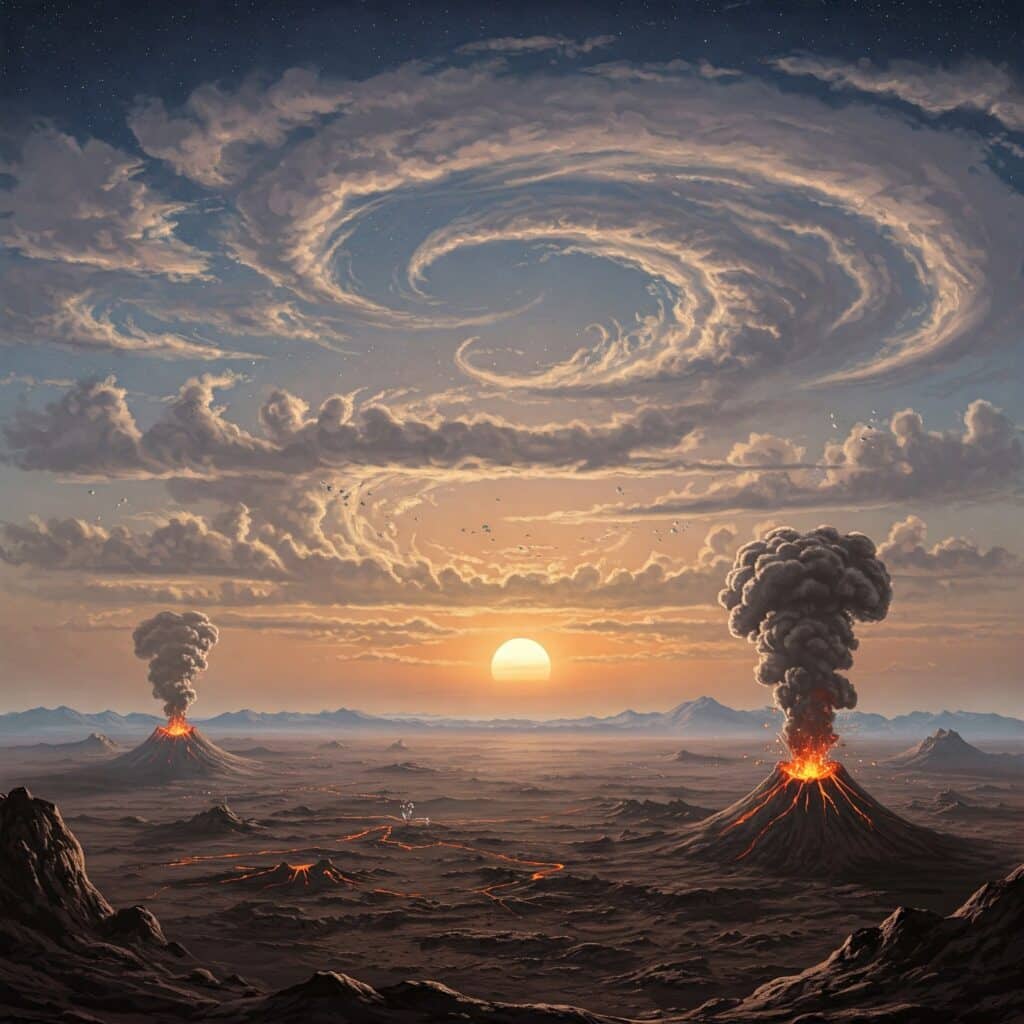Thank you for joining me on this exploration of one of the most fascinating and consequential narratives in Earth’s history—the story of carbon dioxide (CO2). This invisible yet mighty molecule has played a pivotal role in shaping our planet, from its earliest days to the modern challenges we face today. Whether you’re here out of curiosity, concern, or a desire to understand the science behind climate change, your interest is deeply appreciated. Together, we’ll unravel how CO2 has influenced life, climate, and ecosystems across billions of years, drawing on cutting-edge research and scientific evidence from around the globe. By the end of this journey, you’ll not only grasp the significance of CO2 but also see why its story is so intimately tied to our own. So, let’s begin by traveling back to the dawn of Earth itself and tracing the origins of this remarkable gas.
The Dawn of CO2: Earth’s Early Atmosphere

To truly appreciate the role of carbon dioxide in Earth’s history, we must first travel back over 4.5 billion years ago, when our planet was still in its infancy. During this primordial era, Earth’s atmosphere bore little resemblance to what we know today. Scientists believe that early Earth was enveloped in a thick, volatile-rich atmosphere dominated by gases such as hydrogen, helium, methane, ammonia, and water vapor, alongside significant concentrations of carbon dioxide (CO2). Unlike the oxygen-rich air we breathe now, this ancient atmosphere was devoid of free oxygen and teeming with greenhouse gases, with CO2 playing a particularly crucial role in maintaining the planet’s warmth.
Volcanic Activities and Carbon Dioxide History
The origins of this abundant CO2 can be traced to several key processes. One major source was volcanic activity, which released vast quantities of CO2 through eruptions that punctuated Earth’s surface. These emissions were further amplified by the frequent collisions of asteroids and comets during the Late Heavy Bombardment period, approximately 4 billion years ago. These celestial impacts not only delivered additional CO2 but also contributed other volatile compounds that helped shape the early atmosphere. Additionally, the breakdown of minerals in Earth’s crust through chemical weathering released stored carbon into the atmosphere, adding to the growing reservoir of CO2.
This high concentration of CO2 was instrumental in stabilizing Earth’s climate during its formative years. Without it, the young planet—situated farther from the Sun than it is today—would have been an icy wasteland, incapable of supporting the conditions necessary for life. Instead, the greenhouse effect generated by CO2 trapped heat, creating a warm and hospitable environment. This critical role of CO2 in Earth’s early climate underscores its importance as a foundational element of planetary habitability. As we delve deeper into Earth’s history, we will see how this relationship between CO2 and life evolved, setting the stage for the complex interplay that continues to define our planet today.
The Rise of Life and the Great Oxygenation Event
As Earth transitioned from its volatile beginnings to a more stable environment, the emergence of life marked a profound turning point in the planet’s history—and in the story of carbon dioxide. Around 3.5 billion years ago, the first primitive life forms, known as cyanobacteria, began to populate Earth’s oceans. These microscopic organisms possessed a revolutionary ability: photosynthesis. Through this process, they converted sunlight, water, and CO2 into organic matter and oxygen, fundamentally altering the composition of Earth’s atmosphere. Over hundreds of millions of years, these tiny pioneers worked tirelessly, gradually reducing atmospheric CO2 levels while simultaneously releasing oxygen—a transformation that would reshape the planet’s chemistry and climate.
The Great Oxygenation Event (GOE)
The consequences of this biological revolution became evident during the Great Oxygenation Event (GOE), which occurred approximately 2.4 billion years ago. As oxygen accumulated in the atmosphere, it reacted with methane—a potent greenhouse gas—and formed carbon dioxide and water. This shift had a dramatic cooling effect on the planet, triggering a series of global glaciations known as “Snowball Earth” episodes. These extreme ice ages underscored the delicate balance between CO2 and Earth’s climate, as the reduction in greenhouse gases plunged the planet into prolonged periods of deep freeze.
However, life found ways to adapt and thrive even under these harsh conditions. Photosynthetic organisms continued to flourish, driving further reductions in CO2 and enriching the atmosphere with oxygen. This gradual decline in CO2 levels paved the way for the evolution of more complex life forms, including multicellular organisms, which required higher oxygen concentrations to sustain their metabolic processes. Yet, this wasn’t the end of CO2’s influence. Geological processes, such as volcanic eruptions and tectonic activity, periodically replenished atmospheric CO2, ensuring that the planet remained warm enough to support life. This dynamic interplay between biological and geological forces highlights the intricate relationship between CO2, life, and Earth’s climate—a relationship that would continue to evolve over eons.
The Dance of Ice and Fire: CO2 and Climate Cycles
Throughout Earth’s history, carbon dioxide has acted as both a thermostat and a catalyst, orchestrating the planet’s climatic rhythms through a series of natural cycles. One of the most striking examples of this dynamic relationship is the alternation between glacial and interglacial periods during the Quaternary Ice Age, which began roughly 2.6 million years ago. These cycles, driven by variations in Earth’s orbit and axial tilt—known as Milankovitch cycles—were amplified by changes in atmospheric CO2 levels. During glacial periods, lower CO2 concentrations allowed temperatures to plummet, locking vast amounts of water in ice sheets and lowering sea levels. Conversely, during interglacial periods, rising CO2 levels helped warm the planet, melting ice and fostering lush ecosystems. Scientific evidence from ice cores drilled in Antarctica and Greenland reveals this intricate correlation, with CO2 levels fluctuating between approximately 180 parts per million (ppm) during glacial maxima and around 280 ppm during warmer interglacials.

The Demise of Dinosaurs
Volcanic activity has also played a critical role in modulating CO2 levels and influencing Earth’s climate. Massive eruptions, such as those associated with large igneous provinces, have historically injected enormous quantities of CO2 into the atmosphere, triggering periods of rapid warming. For instance, the Siberian Traps eruptions around 252 million years ago are believed to have caused the Permian-Triassic extinction event, often referred to as the “Great Dying,” by releasing catastrophic amounts of CO2 and methane. Similarly, the Deccan Traps eruptions 66 million years ago may have exacerbated the environmental upheaval that contributed to the demise of the dinosaurs. These events underscore the dual nature of CO2: while it sustains life, excessive concentrations can destabilize ecosystems and climates.
Natural carbon sinks, such as forests, oceans, and soils, have long acted as buffers against abrupt changes in CO2 levels. During warmer periods, these sinks absorbed excess CO2, mitigating its warming effects. However, during colder epochs, reduced biological activity and ocean circulation limited this capacity, allowing CO2 to accumulate more readily. This feedback loop highlights the interconnectedness of Earth’s systems and the delicate balance maintained by natural processes. Together, these mechanisms demonstrate how CO2 has shaped Earth’s climate over millennia, serving as both a driver of change and a stabilizing force.
The Anthropocene Era: Humanity’s Impact on CO2 Levels
In recent centuries, humanity has emerged as a dominant force reshaping Earth’s carbon cycle, ushering in what scientists term the Anthropocene era. Since the Industrial Revolution began in the late 18th century, human activities have dramatically altered atmospheric CO2 concentrations, pushing them far beyond natural variability. The burning of fossil fuels—coal, oil, and natural gas—has been the primary driver of this surge. These energy sources, formed from ancient organic matter, release vast amounts of carbon that had been sequestered underground for millions of years. According to data from the Global Carbon Project, annual CO2 emissions from fossil fuel combustion reached approximately 36.8 billion metric tons in 2022 alone, marking a nearly 50% increase since the year 2000.
The role of Forests to control Carbon Dioxide
Deforestation has compounded this impact by reducing the planet’s capacity to absorb CO2. Forests act as vital carbon sinks, capturing CO2 through photosynthesis and storing it in biomass and soil. However, widespread land-use changes, particularly in tropical regions, have led to the destruction of these critical ecosystems. The Food and Agriculture Organization (FAO) estimates that deforestation accounts for nearly 10% of global CO2 emissions annually. Agricultural practices, including livestock farming and rice cultivation, further contribute to rising CO2 levels by releasing carbon stored in soils and vegetation.
The cumulative effect of these activities has been staggering. Atmospheric CO2 concentrations, which hovered around 280 ppm before the Industrial Revolution, surpassed 420 ppm in 2023, according to measurements from the Mauna Loa Observatory. This unprecedented rise has disrupted the natural balance of Earth’s carbon cycle, overwhelming the capacity of oceans and forests to absorb excess emissions. The result is a rapidly warming planet, with cascading impacts on ecosystems, weather patterns, and sea levels. Humanity’s imprint on CO2 levels is undeniable, marking a new chapter in Earth’s history—one defined by both challenge and opportunity for collective action.
Consequences of Rising CO2: A Planet in Peril
The relentless rise in atmospheric CO2 levels is not merely a scientific abstraction; it is a tangible force reshaping the very fabric of life on Earth. One of the most immediate and visible impacts is global warming, as elevated CO2 intensifies the greenhouse effect, trapping heat and driving unprecedented temperature increases. According to the Intergovernmental Panel on Climate Change (IPCC), the planet has already warmed by approximately 1.1°C above pre-industrial levels, with devastating consequences. Melting polar ice caps and glaciers are causing sea levels to rise at an accelerating rate, threatening coastal communities and ecosystems worldwide. Projections suggest that if current trends persist, sea levels could rise by up to 1 meter by the end of the century, displacing millions of people and submerging low-lying areas.
Human societies are also grappling with the cascading effects of rising CO2. Extreme weather events—hurricanes, droughts, heatwaves, and floods—are becoming more frequent and severe, straining infrastructure, economies, and public health systems. Agricultural productivity is under threat as changing precipitation patterns and prolonged droughts disrupt food supplies, exacerbating hunger and inequality. The World Health Organization (WHO) warns that climate change, fueled by CO2 emissions, could cause an additional 250,000 deaths annually between 2030 and 2050 due to malnutrition, malaria, diarrhea, and heat stress. These interconnected crises underscore the urgent need for action to mitigate CO2 emissions and safeguard the planet’s future.
Charting a Sustainable Path Forward
Addressing the escalating crisis of rising CO2 levels demands a multifaceted approach that combines technological innovation, policy reform, and individual responsibility. At the forefront of mitigation efforts are renewable energy technologies, such as solar, wind, and hydropower, which offer sustainable alternatives to fossil fuels. The International Renewable Energy Agency (IRENA) reports that scaling up renewables could reduce global CO2 emissions by 70% by 2050. Simultaneously, advancements in carbon capture and storage (CCS) technologies hold promise for directly removing CO2 from industrial processes and the atmosphere. Projects like the Orca plant in Iceland, the world’s largest direct air capture facility, exemplify how these innovations can complement broader emission-reduction strategies.
Policy measures are equally critical in driving systemic change. Governments worldwide must enforce stricter regulations on emissions, incentivize clean energy adoption, and implement carbon pricing mechanisms to internalize the environmental costs of fossil fuel use. The Paris Agreement, adopted by 196 parties, serves as a cornerstone of global cooperation, aiming to limit global warming to well below 2°C above pre-industrial levels. Strengthening national commitments and ensuring accountability will be pivotal in achieving these targets.
Reflections on Our Shared Responsibility
As we conclude this exploration of Earth’s carbon dioxide history, it’s clear that CO2 is far more than a simple molecule—it is a thread woven into the very fabric of our planet’s past, present, and future. From its role in stabilizing early Earth’s climate to its current status as a driver of global change, CO2’s story is inseparable from the story of life itself. Understanding this narrative empowers us to confront the challenges ahead with clarity and purpose. Each of us has a part to play, whether through personal choices, community engagement, or advocacy for systemic change. By embracing this shared responsibility, we honor not only the legacy of our planet but also the generations yet to come. Thank you for embarking on this journey of discovery—you are a vital part of the solution.
